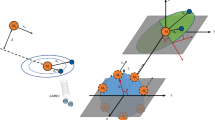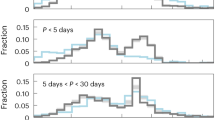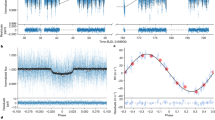Abstract
The formation of super-Earths, the most abundant planets in the Galaxy, remains elusive. These planets have masses that typically exceed that of the Earth by a factor of a few, appear to be predominantly rocky, although often surrounded by H/He atmospheres, and frequently occur in multiples. Moreover, planets that encircle the same star tend to have similar masses and radii, whereas those belonging to different systems exhibit remarkable overall diversity. Here we advance a theoretical picture for rocky planet formation that satisfies the aforementioned constraints: building upon recent work, which has demonstrated that planetesimals can form rapidly at discrete locations in the disk, we propose that super-Earths originate inside rings of silicate-rich planetesimals at approximately ~1 au. Within the context of this picture, we show that planets grow primarily through pairwise collisions among rocky planetesimals until they achieve terminal masses that are regulated by isolation and orbital migration. We quantify our model with numerical simulations and demonstrate that our synthetic planetary systems bear a close resemblance to compact, multi-resonant progenitors of the observed population of short-period extrasolar planets.
This is a preview of subscription content, access via your institution
Access options
Access Nature and 54 other Nature Portfolio journals
Get Nature+, our best-value online-access subscription
$29.99 / 30 days
cancel any time
Subscribe to this journal
Receive 12 digital issues and online access to articles
$119.00 per year
only $9.92 per issue
Buy this article
- Purchase on Springer Link
- Instant access to full article PDF
Prices may be subject to local taxes which are calculated during checkout



Similar content being viewed by others
Data availability
Ascii output files summarizing the time series of our reference simulation (with an output interval of 1,000 years, totalling 1,010 files) are provided at https://www.konstantinbatygin.com/setimeseries.
Code availability
This work utilizes the publicly available mercury6 code (https://www.arm.ac.uk/~jec/). The subroutine detailing user-defined forces is available on request from the corresponding author (K.B.).
References
Chatterjee, S. & Tan, J. C. Inside-out planet formation. Astrophys. J. 53, 780 (2014).
Drażkowska, J., Alibert, Y. & Moore, B. Close-in planetesimal formation by pile-up of drifting pebbles. Astron. Astrophys. 594, A105 (2016).
Morbidelli, A. et al. Contemporary formation of early Solar System planetesimals at two distinct radial locations. Nat. Astron. 6, 72–79 (2022).
Cai, M. X., Tan, J. C. & Portegies Zwart, S. Inside-out planet formation: VI. Oligarchic coagulation of planetesimals from a pebble ring? Mon. Not. R. Astron. Soc. 510, 5486–5499 (2022).
Lichtenberg, T., Drażkowska, J., Schönbächler, M., Golabek, G. J. & Hands, T. O. Bifurcation of planetary building blocks during Solar System formation. Science 371, 365–370 (2021).
Izidoro, A. et al. Planetesimal rings as the cause of the Solar System’s planetary architecture. Nat. Astron. 6, 357–366 (2021).
Youdin, A. N. & Goodman, J. Streaming instabilities in protoplanetary disks. Astrophys. J. 620, 459–469 (2005).
Johansen, A. & Youdin, A. Protoplanetary disk turbulence driven by the streaming instability: nonlinear saturation and particle concentration. Astrophys. J. 662, 627–641 (2007).
Güttler, C., Blum, J., Zsom, A., Ormel, C. W. & Dullemond, C. P. The outcome of protoplanetary dust growth: pebbles, boulders, or planetesimals? I. Mapping the zoo of laboratory collision experiments. Astron. Astrophys. 513, A56 (2010).
Batygin, K. & Morbidelli, A. Self-consistent model for dust–gas coupling in protoplanetary disks. Astron. Astrophys. 666, A19 (2022).
Lissauer, J. J. Planet formation. Ann. Rev. Astron. Astrophys. 31, 129–174 (1993).
Kokubo, E. & Ida, S. Formation of protoplanets from planetesimals in the solar nebula. Icarus 143, 15–27 (2000).
Safronov, V. S. Evoliutsiia Doplanetnogo Oblaka (Nauka, 1969).
Batygin, K. & Morbidelli, A. Formation of giant planet satellites. Astrophys. J. 894, 143 (2020).
Tanaka, H., Takeuchi, T. & Ward, W. R. Three-dimensional interaction between a planet and an isothermal gaseous disk. I. Corotation and Lindblad torques and planet migration. Astrophys. J. 565, 1257–1274 (2002).
Thompson, S. E. et al. Planetary candidates observed by Kepler. VIII. A fully automated catalog with measured completeness and reliability based on Data Release 25. Astrophys. J. Suppl. Ser. 235, 38 (2018).
Petigura, E. A. Two views of the radius gap and the role of light curve fitting. Astron. J. 160, 89 (2020).
Weiss, L. M. et al. The California-Kepler Survey. V. Peas in a pod: planets in a Kepler multi-planet system are similar in size and regularly spaced. Astron. J. 155, 48 (2018).
Millholland, S., Wang, S. & Laughlin, G. Kepler multi-planet systems exhibit unexpected intra-system uniformity in mass and radius. Astrophys. J. 849, L33 (2017).
Adams, F. C., Batygin, K., Bloch, A. M. & Laughlin, G. Energy optimization in extrasolar planetary systems: the transition from peas-in-a-pod to runaway growth. Mon. Not. R. Astron. Soc. 493, 5520–5531 (2020).
Canup, R. M. & Ward, W. R. Formation of the Galilean satellites: conditions of accretion. Astron. J. 124, 3404–3423 (2002).
Millholland, S. C., He, M. Y. & Zink, J. K. Edge-of-the-multis: evidence for a transition in the outer architectures of compact multiplanet systems. Astron. J. 164, 72 (2022).
Izidoro, A. et al. Breaking the chains: hot super-Earth systems from migration and disruption of compact resonant chains. Mon. Not. R. Astron. Soc. 470, 1750–1770 (2017).
Goldberg, M. & Batygin, K. Architectures of compact super-Earth systems shaped by instabilities. Astron. J. 163, 201 (2022).
Matsumoto, Y. & Ogihara, M. Breaking resonant chains: destabilization of resonant planets due to long-term mass evolution. Astrophys. J. 893, 43 (2020).
Spalding, C., Marx, N. W. & Batygin, K. The resilience of Kepler systems to stellar obliquity. Astron. J. 155, 167 (2018).
Pu, B. & Wu, Y. Spacing of Kepler planets: sculpting by dynamical instability. Astrophys. J. 807, 44 (2015).
Chambers, J. E. A hybrid symplectic integrator that permits close encounters between massive bodies. Mon. Not. R. Astron. Soc. 304, 793–799 (1999).
Peng, S. & Batygin, K. Interactions among noninteracting particles in planet formation simulations. Astrophys. J. 898, L46 (2020).
Morbidelli, A., Bottke, W. F., Nesvorný, D. & Levison, H. F. Asteroids were born big. Icarus 204, 558–573 (2009).
Wisdom, J. & Holman, M. Symplectic maps for the N-body problem. Astron. J. 102, 1528–1538 (1991).
Press, W. H., Teukolsky, S. A., Vetterling, W. T. & Flannery, B. P. Numerical Recipes in FORTRAN. The Art of Scientific Computing (Cambridge University Press, 1992).
Mestel, L. On the galactic law of rotation. Mon. Not. R. Astron. Soc. 126, 553 (1963).
Bitsch, B., Johansen, A., Lambrechts, M. & Morbidelli, A. The structure of protoplanetary discs around evolving young stars. Astron. Astrophys. 575, A28 (2015).
Lambrechts, M. et al. Formation of planetary systems by pebble accretion and migration. How the radial pebble flux determines a terrestrial-planet or super-Earth growth mode. Astron. Astrophys. 627, A83 (2019).
Drazkowska, J. et al. Planet formation theory in the era of ALMA and Kepler: from pebbles to exoplanets. Preprint at https://arxiv.org/abs/2203.09759 (2022).
Weidenschilling, S. J. Aerodynamics of solid bodies in the solar nebula. Mon. Not. R. Astron. Soc. 180, 57–70 (1977).
Malhotra, R. Orbital resonances in the solar nebula: strengths and weaknesses. Icarus 106, 264–273 (1993).
Adachi, I., Hayashi, C. & Nakazawa, K. The gas drag effect on the elliptical motion of a solid body in the primordial solar nebula. Prog. Theor. Phys. 56, 1756–1771 (1976).
Armitage, P. J. Astrophysics of Planet Formation (Cambridge University Press, 2010).
Ward, W. R. Protoplanet migration by nebula tides. Icarus 126, 261–281 (1997).
Nelson, R. P. Planetary migration in protoplanetary disks. in Handbook of Exoplanets (eds Deeg, H. J. & Belmonte, J. A.) (Springer, 2018).
Lyra, W., Paardekooper, S.-J. & Mac Low, M.-M. Orbital migration of low-mass planets in evolutionary radiative models: avoiding catastrophic infall. Astrophys. J. 715, L68–L73 (2010).
Bitsch, B., Morbidelli, A., Lega, E. & Crida, A. Stellar irradiated discs and implications on migration of embedded planets. II. Accreting discs. Astron. Astrophys. 564, A135 (2014).
Tanaka, H. & Ward, W. R. Three-dimensional interaction between a planet and an isothermal gaseous disk. II. Eccentricity waves and bending waves. Astrophys. J. 602, 388–395 (2004).
Papaloizou, J. C. B. & Larwood, J. D. On the orbital evolution and growth of protoplanets embedded in a gaseous disc. Mon. Not. R. Astron. Soc. 315, 823–833 (2000).
Koenigl, A. Disk accretion onto magnetic T Tauri stars. Astrophys. J. 370, L39 (1991).
Masset, F. S., Morbidelli, A., Crida, A. & Ferreira, J. Disk surface density transitions as protoplanet traps. Astrophys. J. 642, 478–487 (2006).
Paardekooper, S.-J. & Johansen, A. Giant planet formation and migration. Space Sci. Rev. 214, 38 (2018).
Batygin, K. Capture of planets into mean-motion resonances and the origins of extrasolar orbital architectures. Mon. Not. R. Astron. Soc. 451, 2589–2609 (2015).
Deck, K. M. & Batygin, K. Migration of two massive planets into (and out of) first order mean motion resonances. Astrophys. J. 810, 119 (2015).
Izidoro, A. et al. Formation of planetary systems by pebble accretion and migration. Hot super-Earth systems from breaking compact resonant chains. Astron. Astrophys. 650, A152 (2021).
Ormel, C. W. & Klahr, H. H. The effect of gas drag on the growth of protoplanets. Analytical expressions for the accretion of small bodies in laminar disks. Astron. Astrophys. 520, A43 (2010).
Lambrechts, M. & Johansen, A. Rapid growth of gas-giant cores by pebble accretion. Astron. Astrophys. 544, A32 (2012).
Dubrulle, B., Morfill, G. & Sterzik, M. The dust subdisk in the protoplanetary nebula. Icarus 114, 237–246 (1995).
Ormel, C. W. in Formation, Evolution, and Dynamics of Young Solar Systems 197 (2017).
Acknowledgements
K.B. is grateful to Caltech, Observatoire de la Côte d’Azur, the David and Lucile Packard Foundation and the National Science Foundation (grant number: AST 2109276) for their generous support. A.M. is grateful for support from the ERC advanced grant HolyEarth N. 101019380.
Author information
Authors and Affiliations
Contributions
K.B. and A.M. jointly conceived the project and collaborated on the interpretation of the results. K.B. carried out the N-body simulations and led the writing of the paper. A.M. ran particle-in-a-box simulations and contributed to writing the manuscript.
Corresponding authors
Ethics declarations
Competing interests
The authors declare no competing interests.
Peer review
Peer review information
Nature Astronomy thanks Lauren Weiss and the other, anonymous, reviewer(s) for their contribution to the peer review of this work.
Additional information
Publisher’s note Springer Nature remains neutral with regard to jurisdictional claims in published maps and institutional affiliations.
Extended data
Extended Data Fig. 1 Mass budget of solids within a ringed protoplanetary disk.
Output of the disk evolution model delineated in ref. 3. Owing to a hydrodynamic balance between the radial outflow and drag exerted on dust by gas, solids concentrate in the vicinity of their respective sublimation lines, forming planetesimals within discrete rocky and icy rings. Depending on the minimal level of turbulent viscosity that the disk can attain, \({\alpha }_{\min }\), the mass entrained within the r ~ 1 AU annulus of silicate-rich material varies drastically. Importantly, for relatively quiescent nebulae, the rock ring can reach masses on the order of tens of M⊕, readily serving as the birthplace of super-Earths.
Rights and permissions
Springer Nature or its licensor (e.g. a society or other partner) holds exclusive rights to this article under a publishing agreement with the author(s) or other rightsholder(s); author self-archiving of the accepted manuscript version of this article is solely governed by the terms of such publishing agreement and applicable law.
About this article
Cite this article
Batygin, K., Morbidelli, A. Formation of rocky super-earths from a narrow ring of planetesimals. Nat Astron 7, 330–338 (2023). https://doi.org/10.1038/s41550-022-01850-5
Received:
Accepted:
Published:
Issue Date:
DOI: https://doi.org/10.1038/s41550-022-01850-5



